So you’re thinking about incorporating turkey tail mushrooms into your daily routine, but are wondering if there are any side effects or potential drug interactions to consider.
You’ve come to the right place!
It’s always important to consult both your physician and pharmacist before incorporating natural remedies into your daily routine. And it’s important to note that due to an overwhelming lack of scientific study, we still aren’t 100% sure what side effects or interactions there are when taking turkey tail supplements.
But this blog will act as a great starting point for a conversation with your doctor.
In this post, we will discuss turkey tail’s side effects, dosing requirements, and toxicology (or lack thereof). Let’s dig a little deeper into the topic and discuss what we know about turkey tail today.
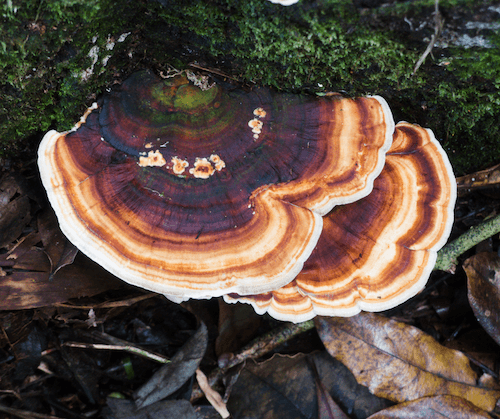
First, let’s quickly review:
What are turkey tail mushrooms?
Turkey tail mushrooms (Trametes versicolor) are considered one of the most well-documented and important edible medicinal mushrooms for immunotherapy and cancer care. A great starter mushroom to collect while foraging in the wild, turkey tail can be found growing on decayed logs in forests all over the globe and is not specific to a certain type of tree. (Remember to work with a professional mycologist before foraging by yourself!) You will most likely find turkey tail growing on hardwoods, like oak trees.
Turkey tail fruiting bodies taste sweet and mild and are sold commercially as a tincture, tea, or capsule across North America, Asia, and Europe.
How are turkey tail mushrooms used?
Turkey tail mushrooms have been used as a cancer treatment for over 30 years in Japan. In more recent years, this mushroom has made its way onto the Western world’s radar and the multicolored species has been studied in numerous clinical trials. These studies have found that turkey tail contains one of the highest percentages of beta-glucans (more than 50% of the mushroom’s makeup), and it’s also been found that the Polysaccharopeptide-K (PSK) concentrate derived from turkey tail enhances immune function.
Furthermore, turkey tail has been shown to help with:
- Gut health
- Antibacterial properties (namely salmonella or staph)
- Efficacy of certain cancer treatments
- Combatting HPV
- Inflammation
- Athletic performance (increased energy)
- Insulin resistance
- Phlegm reduction
- Pulmonary disorders
In a Japanese postoperative study on the effects of PSK on gastric cancer, it was shown that the group given mitomycin C (MMC), futraful (FT), and PSK (e.g., turkey tail concentrate) had the best survival rate with positive lymph node metastases. This promising study, along with many others, is paving the way for more possibilities to use turkey tail for positive health outcomes.
But there is still a lot to learn about this mushroom.
What are the common side effects of taking turkey tail mushrooms?
Although many studies on turkey tail mushrooms have shown promising results for cancer treatment, immunotherapy, preventing and treating upper respiratory, urinary, and digestive tract infections, and cholesterol regulation, it is not FDA approved at this time. Because the mushroom is edible, the lack of FDA approval is less concerning and it’s been shown that there are very few, if any, adverse side effects when taking turkey tail, making it a very safe mushroom to consume.
With all of this in mind, it’s still important to consider that turkey tail consumption affects each person differently.
People who have pre-existing health conditions or are allergic to mushrooms or mold should consult a trusted healthcare professional before consuming turkey tail.
The six documented potential side effects of taking turkey tail include:
- Heartburn
- Cold/flu symptoms
- Constipation and stomach pain
- Rash
- Darkened nail pigmentation
- Diarrhea (darkened stool)
Also, it’s generally recommended to avoid taking turkey tail mushrooms if you are pregnant or breastfeeding.
The good news is that, even with side effects presenting themselves in some cases, it’s never been documented that someone has had irreversible side effects from taking turkey tail.
Possible interactions from turkey tail mushrooms
Out of all the research conducted on turkey tail mushrooms, reputable information on possible Rx drug interactions is lacking. Today, there have been no reported negative interactions when traditional medications and turkey tail have been taken in tandem, but that doesn’t mean it’s impossible. If you are taking medication and would like to start taking turkey tail, consider talking to your doctor before you start dosing regularly.
Turkey tail mushroom dosage
As with anything, dosage can differ person-to-person based on size, weight, and tolerance. When starting to take turkey tail, it’s recommended to use 1-3 grams of powdered extract daily. For capsule supplements, start by taking two “00” supplements per day (e.g., two 400-500 mg). After taking turkey tail for some time, if a higher dose is desired, you can double the amount.
If you’re considering taking turkey tail to enhance cancer treatment or aid in a cancer diagnosis, it’s recommended to first consult your doctor. If they agree that’s a good choice for your health, it’s recommended to take 3 grams of turkey tail PSK concentrate per day alongside traditional chemotherapy.
How do most people take turkey tail mushrooms?
As with most mushroom varieties, there are a number of ways you can consume turkey tail. We've compiled a full guide to taking turkey tail supplements. The most common ways people take turkey tail mushrooms include:
- Turkey tail powder: Turkey tail powder, ak.a. powdered turkey tail mushroom, has been used as a supplement for decades. Turkey tail powder can be mixed into your favorite beverage of choice, It’s recommended to start at 1-3 grams of turkey tail powder daily and increase after baseline tolerance is established.
- Turkey tail extract: Turkey tail extract takes turkey tail powder and boils it down using a non-alcoholic liquid boiling process to make a liquid extract. Similar to the powder, this product can easily be added to your favorite beverage or food item. Dosage will vary by bottle and product, so please consult the directions before taking. The general rule is to take 1mL of turkey tail extract (approximately 45 droplets) two times daily.
- Turkey tail extract capsules: If turkey tail extract or tincture isn’t for you, consider taking it in a capsule format with turkey tail capsules. Recommended dosage is two “00” (e.g., 500 mg) capsules daily.
- Turkey tail tincture: Turkey tail alcohol-based tinctures are considered inferior to turkey tail extracts because active beta-glucans are not soluble in alcohol. Similar to turkey tail extract, turkey tail tincture comes in a liquid format. Dosage will vary by bottle and product, so please consult the directions before taking - dosage will resemble turkey tail extract dosage (e.g., 1mL of turkey tail extract - approximately 45 droplets) two times daily). Make sure you review your product’s extract process as well as the guaranteed beta-glucan analysis before using a tincture for functional or medicinal purposes.
When is the best time to take turkey tail mushrooms?
The best time to take turkey tail mushrooms differs person-to-person, but there is evidence to suggest that taking it daily for up to 10 years has shown positive results for cancer patients.
For those who are looking to take turkey tail for general health and wellbeing, it’s recommended to take it once per day as a starting point and adjust accordingly over time.
The final word on turkey tail mushrooms for today
With turkey tail mushrooms being one of the most researched and well-documented mushrooms on the market, it’s a great way to dip your toe into the mushroom consumption world. Want to learn more about turkey tail? You can do so here.

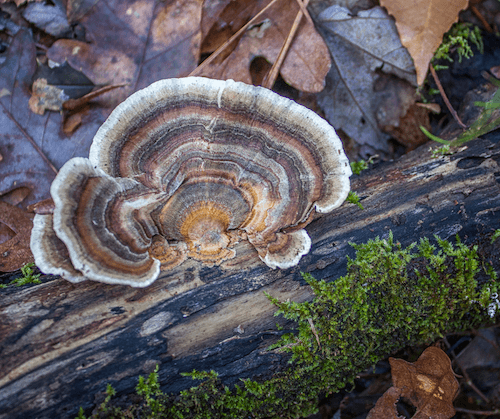
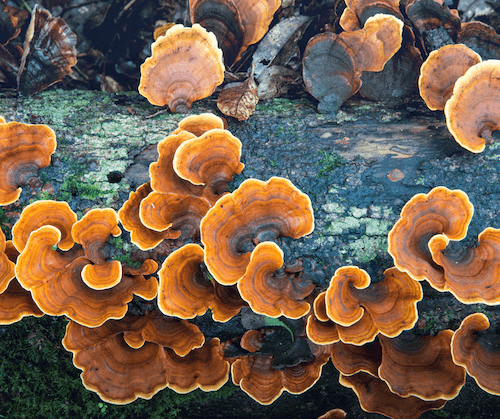

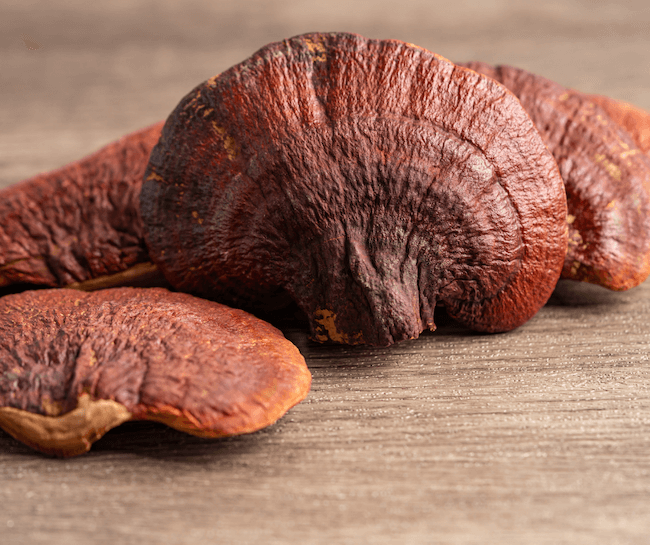
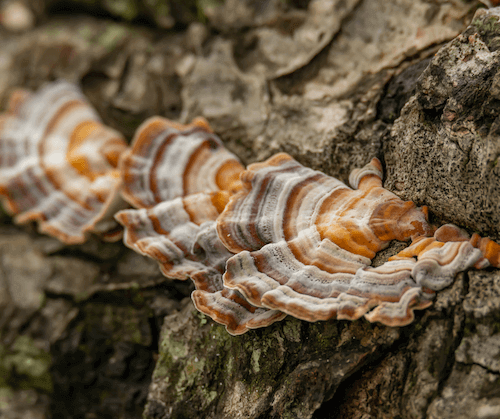


.png)
